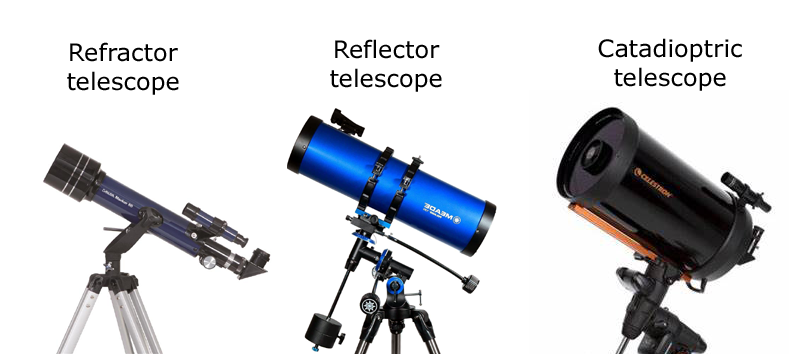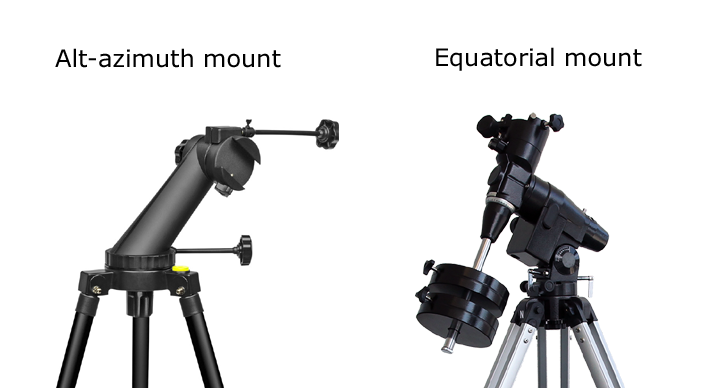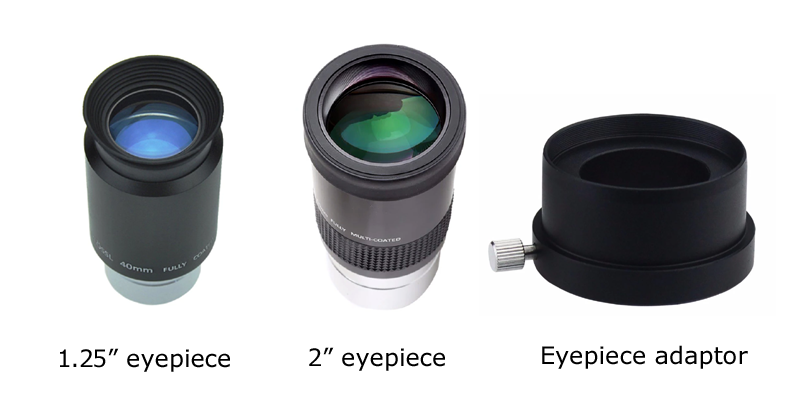How to Choose Your First Telescope
Refractor or Reflector or Catadioptric Telescope?
Telescopes are classified according to the types of optical systems into reflectors, refractors and catadioptrics. What type of the telescope would be best for the observations you are going to conduct?

The refractor is a better choice if you are going to look at the planets and the Moon. Refractors use glass lenses up in front, and have a simple design. They produce a very clean and sharp image. Refractors work better for higher magnifications. Apochromatic refractor uses a compound lens as objective which almost removes image distortion and produces an even sharper and cleaner image. However, large diameter lenses are expensive.
If you are going to look at deep sky objects then a reflector is a better choice. Deep space objects like galaxies and nebulae are faint, and it is necessary to collect more light to make them visible on an image. That is why in this case you need a telescope with a larger aperture. Reflectors with larger apertures are less expensive than refractors. Reflector’s objective is a mirror which is easier to produce than a same size lens for a refractor. Most inexpensive reflectors with large apertures are dobsonian telescopes.
A little downside of a reflector in comparison with a refractor is that it needs periodic collimating. The collimation is an adjustment of the primary mirror of the reflector, so it is in line with a secondary mirror. It is not very difficult to learn how to do collimation. However, if you are going to get a reflector, you should better be ready to collimate it after telescope carrying or transporting.
The third type of telescopes are catadioptrics (or Cassegrains). Catadioptric telescopes use both lenses and mirrors in their optical system and have some advantages over reflectors and refractors. Because of their optical design, catadioptrics have long focal length and short tube length. The optical system of a catadioptric telescope makes image distortion very small. So they are good for observing planets and the Moon surface as refractors. Catadioptrics are convenient because they are lightweight and small. So they will be a good choice if you are going to take a telescope on a trip or your place of observations is far from the place where you store the telescope. As to the price, catadioptrics are more expensive than reflectors of the same aperture, but more affordable than refractors.
More detailed description of the telescope’s optical systems and their pros and cons are given in this article.
Long or Short Focal Length?
If the aperture is a major characteristic of a telescope, then the focal length of the objective is its second important specification. So, the wise thing to do is to find out what the focal length of the objective the telescope you are considering has. The objective focal length influences magnification and the size of the image. The magnification is directly proportional to the objective focal length. High magnification is desirable when you look at the Moon or planets’ details, so in this case you need a longer focal length. Short focal length will give you a wide field of view which is required when you observe extended deep sky objects like galaxies and nebulae.
Alt-Azimuth or Equatorial Mount?
The telescope tube is mounted on a stand that rotates to point the telescope at the observed objects. There are so called “alt-azimuth” and “equatorial” mounts, and you need to choose one of them.

Equatorial mounts are more professional, as they allow tracking of night sky objects as they move around the sky. However, the equatorial mount is harder to operate, and it takes time and patience to learn how to deal with it. Alt-azimuth mount moves the tube up-down and right-left, so it is intuitively easy to operate for a novice astronomer. That is why alt-azimuth mount is recommended for beginners. Of course, you can choose an equatorial mount too, if you are willing to put in the effort to learn how to handle it. The equatorial mount is preferred for astrophotography, because serious astrophotography requires object tracking.
Goto or Manual Mount?
When looking for your first telescope, another arrangement you may come across is a mount called a “goto mount.” It is a motorized and computerized mount with a handheld which automatically aims the telescope tube at the night sky object of your choice. One thing to bear in mind is that sometimes goto mounts are offered with small aperture telescopes. And although the database of the telescopes’ computer contains, perhaps, tens of thousands of objects in the night sky, because of the small aperture, you can actually see only a small part of them in such a telescope. Another thing to consider is that goto mount has its price. And for the same amount of money you have a choice to get a goto mount or to get a telescope with a larger aperture.
What Size Eyepieces Can I Use with This Telescope?
The most important accessory for a telescope are eyepieces. You can use various eyepieces with one telescope, because they are easily inserted and removed from the telescope focuser.
By changing the eyepieces, you can change the magnification and field of view. Wide field of view is good for locating night sky objects, for observing faint deep-sky objects or very large objects. When you buy a telescope, it usually comes with a minimal set of low or moderate quality eyepieces. You can get additional eyepieces later for your future observational tasks.

Modern eyepieces have a barrel diameter of 1.25” or 2”. The 2” eyepieces are more professional, and usually give an image of better quality. Another advantage of 2″ eyepieces is that they can give a wide field of view even for low magnifications. Some telescopes (usually cheaper ones) accept 1.25” eyepieces only. Other telescopes have an eyepiece adapter which accepts both types of eyepieces. If you buy a telescope which comes with 1.25” eyepieces, you probably may want to use more professional 2” eyepieces later on. That is why it is a good idea to know beforehand whether the telescope you choose can be used with 2” eyepieces.
